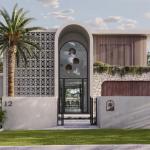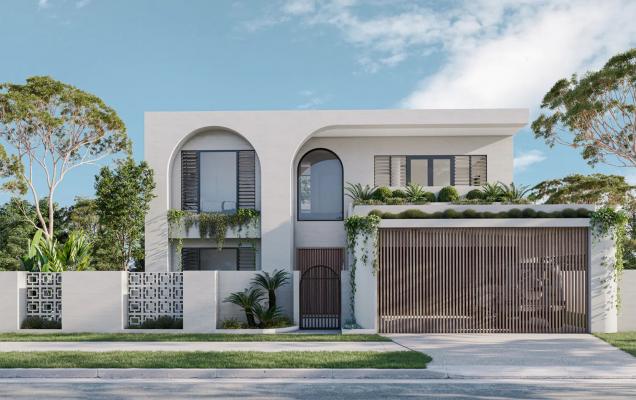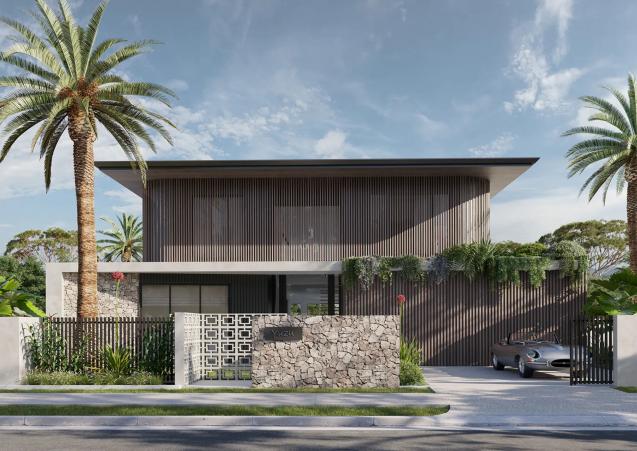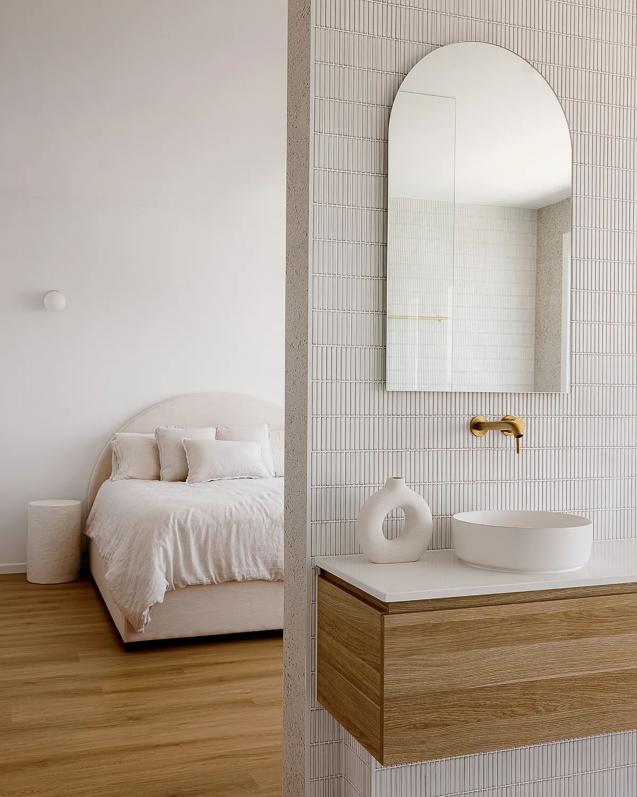
Split-Level Home Designs: Definition, Features & Benefits
By Unique Built|February 22, 2024
Forget the cookie-cutter designs of yesteryear; split-level homes are the architectural equivalent of a plot twist in your novel. They're like the Rubik's Cube of home design – complex, fascinating, and oh-so-satisfying once you figure them out.
Split-level homes have a story to tell – one of innovation, adaptability, and a touch of rebellion against the mundane. They're not just a fleeting trend but a thoughtful response to modern living needs, balancing intimacy with openness, tradition with innovation. So, let's discuss the layers of split-level houses together and discover why these homes might just be the hidden gem you've been searching for.
What Exactly is a Split-Level Home?
A Split-level home is a style of home in which the floor levels are staggered and is typically built on a sloping block. Often, you have two short sets of stairs (one going up, the other down) from the main entrance level. It's like the house decided to split its levels to create more distinct living areas without fully committing to a full two-story design. It's the architectural equivalent of dipping your toes in the water to test the temperature – not too high, not too low.
The split-level style gained popularity in the US during the mid-20th century. It emerged as a response to the growing demand for more living space, without the footprint or cost of a traditional two-story home. Think of it as the 1950s answer to a suburban dream – a middle ground between the bungalow and the mansion.
But here's the kicker – split-level homes are more than just a nostalgic nod to the past. They are a smart architectural choice even today. For starters, they offer a brilliant way to maximise space on a smaller plot of land. You get the perks of separate living areas without the sprawl of a large single-story home. It's the architectural equivalent of having your cake and eating it too.
For engineers, the split-level design poses an interesting challenge – balancing the house structurally on different levels of a sloping block, while keeping it aesthetically pleasing. And for homeowners, it's about getting more bang for your buck, creating distinct living zones, and adding a bit of character to your suburban oasis.
The Features of a Split-Level House
Staggered Floors
Instead of a traditional layout where all rooms exist on one plane, staggered floors introduce multiple levels within a single home. This isn't just about aesthetics; it's about creating distinct living areas without the need for extensive hallways or wasted space.
For you, the homeowner, this means more room for your lifestyle needs. And for the engineers among us, it's a delightful challenge in balancing structure and functionality.
Short Staircases
In split-level homes, you won't find those long, daunting flights of stairs you might dread in a typical two-story house. Here, we have short, manageable staircases connecting the different levels.
These staircases are a game-changer. They make moving between the levels an easy, almost seamless experience. And from a design perspective, they're an opportunity to integrate creative elements, like hidden storage or eye-catching banisters, without overwhelming the space.
Distinct Zones: A Place for Everything
The magic of split-level homes lies in their ability to create distinct zones for living, sleeping, and everything in between. Think of your house as a well-organised bookshelf, where each shelf holds a different story.
This zoning is particularly beneficial for families or individuals who crave both communal and private spaces within their homes. It's a layout that respects the need for personal retreats while still fostering shared experiences in common areas.
For the engineers, this zoning presents an intriguing puzzle. How do you design a home that flows naturally but still keeps its distinct areas? It's a challenge, but one that's incredibly rewarding when done right.
Why Split-Level Houses Are Secretly Awesome
You see, these architectural marvels aren't just about an appealing design; they're a powerhouse of benefits that often fly under the radar. And they're not just good; they're secretly awesome.
Energy Efficiency
Now, you might not immediately associate split-level houses with being energy-efficient, but here's the surprise – they excel in this area. Due to their unique design, these homes often have a smaller roof and less exterior wall area exposed to the elements compared to a traditional two-story home. What does this mean for you? Well, it's simple: better insulation and less energy spent on heating and cooling. Engineers, take a moment to appreciate the clever use of space and resources here. It's not just about looking good; it's about being smart with what we have.
Natural Light
Sloping block house designs are engineered with this in mind, featuring layouts that allow light to penetrate through multiple levels of the home. This isn't just about saving on your electricity bill; it's about creating a living space that lifts your mood and brings a bit of the great outdoors inside. The placement of windows in these homes is no accident – it's a thoughtful design choice that brings a touch of sunshine to your daily life.
Stand Out from the Crowd
And now, for the curb appeal. Split-level homes have a unique aesthetic that sets them apart from the sea of cookie-cutter houses. They offer a visual interest that's both subtle and striking. As a homeowner, you get a house that stands out, and as an engineer, you get to admire the structural finesse that goes into creating such a distinctive look.
Fit for Various Lifestyles
These homes aren't just a one-size-fits-all. They are versatile enough to fit various lifestyles, whether you're a bustling family needing separate living spaces or a couple looking for an efficient, cosy home. The split-level design offers distinct zones for living, working, and relaxing, all while maintaining a seamless flow throughout the home. Engineers, isn't it fascinating how such a practical design can also be so flexible and adaptable?
Tailoring a Split-Level to Your Life
Ah, the art of customisation! This is where split-level houses really start to strut their stuff. You see, these architectural gems aren’t just about the unique floor plan; they’re a canvas for your personal touch, whether you’re an engineer with a keen eye for structure or a homeowner with a vision for interior design.
Let’s talk about you, the engineers out there. Split-level houses are like a playground for your structural creativity. Each level offers a new perspective and challenge. Think about the potential for integrating sustainable materials or experimenting with non-traditional layouts. It’s your chance to push the boundaries of conventional design, all while ensuring the integrity and functionality of the home. And don’t worry, you don’t need to reinvent the wheel – sometimes, the subtlest tweaks make the most significant impact.
Now, for you, the homeowners, this is where you get to let your personality shine. Each staggered section of a split-level home is a new opportunity to express yourself. From choosing the colour palette that reflects your mood to selecting furniture that fits just right in the quirky corners of your home, every decision is a reflection of your style. You can create distinct living zones - maybe a cosy reading nook under the stairs or a vibrant entertainment area in the lower level. And the best part? You don’t need an engineering degree to figure out how to make your space look and feel fabulous.
In the world of split-level homes, the phrase “one size fits all” is laughably obsolete. These houses are all about adapting to your lifestyle, not the other way around. Whether you’re an engineer playing with the bones of the building or a homeowner dressing up the interiors, the split-level house gracefully accommodates your individuality.
Modern Twists on the Classic Split-Level
Gone are the days when split-level houses were a mere reflection of the 1950s lifestyle. Today, they are at the forefront of modern architectural innovation, merging the nostalgic charm with contemporary flair. You might be thinking, "How exactly?"
Embracing Technology in Design
Modern split-level homes aren't just about the unique floor plan; they're incorporating smart home technology in ways that would make even the Jetsons jealous. Imagine controlling your lighting, temperature, and security systems all from your smartphone. And it's not just about convenience. These technological integrations are redefining living spaces, making them more efficient, safer, and, let's face it, a whole lot cooler.
But don't worry, you don't need a degree in computer science to understand the beauty of these tech integrations. It's all about enhancing the living experience while keeping things user-friendly. Think of it as your home having a bit of an IQ boost, without any of the haughtiness.
Sustainability
Now, onto sustainability – a term that's thrown around a lot these days, but in the case of split-level homes, it's genuinely transformative. Modern split-level designs are not just about looking good; they're about doing good too. Energy efficiency is a key player here. From solar panels seamlessly integrated into the roof to high-efficiency windows that make the most of natural light and insulation, these homes are designed to reduce your carbon footprint while keeping your energy bills in check.
And let's not forget materials. Eco-friendly building materials are the unsung heroes in these modern designs. We're talking about sustainably sourced wood, recycled materials, and non-toxic paints. It's like giving Mother Nature a high five with every brick laid.
The Future of Split-Level Homes
So, you see, you don't need a time machine to catch a glimpse of the future of split-level houses. It's already here, and it's pretty impressive. These modern adaptations are breathing new life into a classic design, proving that split-level homes are not just a relic of the past, but a canvas for innovation and forward-thinking.
For information about sloping block house designs, contact the team at Unique Built. Specialist sloping block home builders.
Split-level homes have a story to tell – one of innovation, adaptability, and a touch of rebellion against the mundane. They're not just a fleeting trend but a thoughtful response to modern living needs, balancing intimacy with openness, tradition with innovation. So, let's discuss the layers of split-level houses together and discover why these homes might just be the hidden gem you've been searching for.
What Exactly is a Split-Level Home?
A Split-level home is a style of home in which the floor levels are staggered and is typically built on a sloping block. Often, you have two short sets of stairs (one going up, the other down) from the main entrance level. It's like the house decided to split its levels to create more distinct living areas without fully committing to a full two-story design. It's the architectural equivalent of dipping your toes in the water to test the temperature – not too high, not too low.
The split-level style gained popularity in the US during the mid-20th century. It emerged as a response to the growing demand for more living space, without the footprint or cost of a traditional two-story home. Think of it as the 1950s answer to a suburban dream – a middle ground between the bungalow and the mansion.
But here's the kicker – split-level homes are more than just a nostalgic nod to the past. They are a smart architectural choice even today. For starters, they offer a brilliant way to maximise space on a smaller plot of land. You get the perks of separate living areas without the sprawl of a large single-story home. It's the architectural equivalent of having your cake and eating it too.
For engineers, the split-level design poses an interesting challenge – balancing the house structurally on different levels of a sloping block, while keeping it aesthetically pleasing. And for homeowners, it's about getting more bang for your buck, creating distinct living zones, and adding a bit of character to your suburban oasis.
The Features of a Split-Level House
Staggered Floors
Instead of a traditional layout where all rooms exist on one plane, staggered floors introduce multiple levels within a single home. This isn't just about aesthetics; it's about creating distinct living areas without the need for extensive hallways or wasted space.
For you, the homeowner, this means more room for your lifestyle needs. And for the engineers among us, it's a delightful challenge in balancing structure and functionality.
Short Staircases
In split-level homes, you won't find those long, daunting flights of stairs you might dread in a typical two-story house. Here, we have short, manageable staircases connecting the different levels.
These staircases are a game-changer. They make moving between the levels an easy, almost seamless experience. And from a design perspective, they're an opportunity to integrate creative elements, like hidden storage or eye-catching banisters, without overwhelming the space.
Distinct Zones: A Place for Everything
The magic of split-level homes lies in their ability to create distinct zones for living, sleeping, and everything in between. Think of your house as a well-organised bookshelf, where each shelf holds a different story.
This zoning is particularly beneficial for families or individuals who crave both communal and private spaces within their homes. It's a layout that respects the need for personal retreats while still fostering shared experiences in common areas.
For the engineers, this zoning presents an intriguing puzzle. How do you design a home that flows naturally but still keeps its distinct areas? It's a challenge, but one that's incredibly rewarding when done right.
Why Split-Level Houses Are Secretly Awesome
You see, these architectural marvels aren't just about an appealing design; they're a powerhouse of benefits that often fly under the radar. And they're not just good; they're secretly awesome.
Energy Efficiency
Now, you might not immediately associate split-level houses with being energy-efficient, but here's the surprise – they excel in this area. Due to their unique design, these homes often have a smaller roof and less exterior wall area exposed to the elements compared to a traditional two-story home. What does this mean for you? Well, it's simple: better insulation and less energy spent on heating and cooling. Engineers, take a moment to appreciate the clever use of space and resources here. It's not just about looking good; it's about being smart with what we have.
Natural Light
Sloping block house designs are engineered with this in mind, featuring layouts that allow light to penetrate through multiple levels of the home. This isn't just about saving on your electricity bill; it's about creating a living space that lifts your mood and brings a bit of the great outdoors inside. The placement of windows in these homes is no accident – it's a thoughtful design choice that brings a touch of sunshine to your daily life.
Stand Out from the Crowd
And now, for the curb appeal. Split-level homes have a unique aesthetic that sets them apart from the sea of cookie-cutter houses. They offer a visual interest that's both subtle and striking. As a homeowner, you get a house that stands out, and as an engineer, you get to admire the structural finesse that goes into creating such a distinctive look.
Fit for Various Lifestyles
These homes aren't just a one-size-fits-all. They are versatile enough to fit various lifestyles, whether you're a bustling family needing separate living spaces or a couple looking for an efficient, cosy home. The split-level design offers distinct zones for living, working, and relaxing, all while maintaining a seamless flow throughout the home. Engineers, isn't it fascinating how such a practical design can also be so flexible and adaptable?
Tailoring a Split-Level to Your Life
Ah, the art of customisation! This is where split-level houses really start to strut their stuff. You see, these architectural gems aren’t just about the unique floor plan; they’re a canvas for your personal touch, whether you’re an engineer with a keen eye for structure or a homeowner with a vision for interior design.
Let’s talk about you, the engineers out there. Split-level houses are like a playground for your structural creativity. Each level offers a new perspective and challenge. Think about the potential for integrating sustainable materials or experimenting with non-traditional layouts. It’s your chance to push the boundaries of conventional design, all while ensuring the integrity and functionality of the home. And don’t worry, you don’t need to reinvent the wheel – sometimes, the subtlest tweaks make the most significant impact.
Now, for you, the homeowners, this is where you get to let your personality shine. Each staggered section of a split-level home is a new opportunity to express yourself. From choosing the colour palette that reflects your mood to selecting furniture that fits just right in the quirky corners of your home, every decision is a reflection of your style. You can create distinct living zones - maybe a cosy reading nook under the stairs or a vibrant entertainment area in the lower level. And the best part? You don’t need an engineering degree to figure out how to make your space look and feel fabulous.
In the world of split-level homes, the phrase “one size fits all” is laughably obsolete. These houses are all about adapting to your lifestyle, not the other way around. Whether you’re an engineer playing with the bones of the building or a homeowner dressing up the interiors, the split-level house gracefully accommodates your individuality.
Modern Twists on the Classic Split-Level
Gone are the days when split-level houses were a mere reflection of the 1950s lifestyle. Today, they are at the forefront of modern architectural innovation, merging the nostalgic charm with contemporary flair. You might be thinking, "How exactly?"
Embracing Technology in Design
Modern split-level homes aren't just about the unique floor plan; they're incorporating smart home technology in ways that would make even the Jetsons jealous. Imagine controlling your lighting, temperature, and security systems all from your smartphone. And it's not just about convenience. These technological integrations are redefining living spaces, making them more efficient, safer, and, let's face it, a whole lot cooler.
But don't worry, you don't need a degree in computer science to understand the beauty of these tech integrations. It's all about enhancing the living experience while keeping things user-friendly. Think of it as your home having a bit of an IQ boost, without any of the haughtiness.
Sustainability
Now, onto sustainability – a term that's thrown around a lot these days, but in the case of split-level homes, it's genuinely transformative. Modern split-level designs are not just about looking good; they're about doing good too. Energy efficiency is a key player here. From solar panels seamlessly integrated into the roof to high-efficiency windows that make the most of natural light and insulation, these homes are designed to reduce your carbon footprint while keeping your energy bills in check.
And let's not forget materials. Eco-friendly building materials are the unsung heroes in these modern designs. We're talking about sustainably sourced wood, recycled materials, and non-toxic paints. It's like giving Mother Nature a high five with every brick laid.
The Future of Split-Level Homes
So, you see, you don't need a time machine to catch a glimpse of the future of split-level houses. It's already here, and it's pretty impressive. These modern adaptations are breathing new life into a classic design, proving that split-level homes are not just a relic of the past, but a canvas for innovation and forward-thinking.
For information about sloping block house designs, contact the team at Unique Built. Specialist sloping block home builders.



